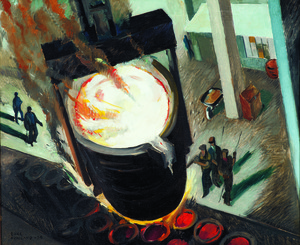Michele & Donald D’Amour Museum of Fine Arts, Second Floor
An exhibition of American Modernist paintings from the 1920s to the beginning of World War II, a period marked by significant change and compounded by the onset of the Great Depression in the 1930s. More than 60 major American Scene paintings illustrate the changes the nation underwent through the eyes of artists who were often poor and out of work.
Influenced by radical art movements taking hold in Europe at the time, the featured artists painted images ranging from urban laborers to Cubist-inspired abstractions, and from fragmented rural landscapes to modern industrial cities and the people that inhabited them. Modern Dialect illustrates the scope of the American modernist aesthetic and the vision and integrity each artist brought to the representation of the American experience.
The exhibit's early modern paintings, such as William Sommer's Adam and Eve, provide a glimpse of an America beginning to assert itself in the art world. Then works like Abraham Harriton’s 6th Avenue Unemployment Agency mirrors a shift in the country's mood to one of desperation caused by the Great Depression. As the economy continued to worsen, painters like Clyde Singer depict the struggle to come to grips with this new reality. Singer's Barn Dance illustrates the attempt to escape the harshness of life with a night of joyful music and dancing, while Louis Ribak's Nocturne, with hooded Klu Klux Klansmen running into the night, shows how the Depression intensified racial tensions.
The collection also features American Abstract artists who conveyed the opposing forces of modern life. Although abstract art was still considered a European phenomenon, it was gaining recognition in America, though still subordinate to Post-impressionism, Regionalism and American Scene painting. Works by George Bellows, John Rogers Cox, Burgoyne Diller, Maurice Freedman, Marsden Hartley, Reginald Marsh, Charles Sheeler and Stuart Walker and are also included in the show.
Organized by the Dixon Gallery and Gardens, Memphis, TN.

